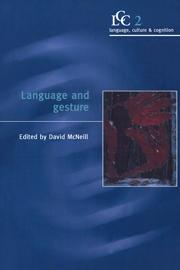Book contents
- Frontmatter
- Contents
- Acknowledgments
- Introduction
- Part 1 Gesture in action
- Part 2 Gesture in thought
- Part 3 Modeling gesture performance
- Part 4 From gesture to sign
- 16 Blended spaces and deixis in sign language discourse
- 17 Gestural precursors to linguistic constructs: how input shapes the form of language
- 18 Gesture to sign (language)
- Index
17 - Gestural precursors to linguistic constructs: how input shapes the form of language
Published online by Cambridge University Press: 07 January 2010
- Frontmatter
- Contents
- Acknowledgments
- Introduction
- Part 1 Gesture in action
- Part 2 Gesture in thought
- Part 3 Modeling gesture performance
- Part 4 From gesture to sign
- 16 Blended spaces and deixis in sign language discourse
- 17 Gestural precursors to linguistic constructs: how input shapes the form of language
- 18 Gesture to sign (language)
- Index
Summary
Introduction
Studies of atypical first-language acquisition have demonstrated the importance of maturation on the outcome of the acquisition process. The age at which individuals are first exposed to a language impacts both language mastery and language-processing abilities in adulthood (Emmorey et al. 1995; Mayberry 1993; Mayberry & Eichen 1991; Newport 1988, 1990). This factor is widely understood to be related to the maturation of the neural substrate for language. Plasticity in neural organization decreases with age, inhibiting late development of sensitivity to linguistic structure. A second factor that has received less attention in the recent literature on language acquisition is the type of input to which the child is exposed. Even when exposure is sufficiently early to influence neural development, the nature of the input can influence the course of acquisition. In the case of spoken language acquisition, it has been suggested that the influence of the input is merely to make the child attend to marked structures in the primary language (e.g., Roeper & Williams 1987). Several cases of very limited input suggest that children will develop more structured systems than they are exposed to (Goldin-Meadow & Mylander 1984, 1990a; Singleton & Newport 1987). These studies might be construed to support the view that input plays little role in the course of acquisition relative to the factor of age of exposure; that is, input only guides a process that is primarily an expression of structure that is already in place, or innate.
- Type
- Chapter
- Information
- Language and Gesture , pp. 358 - 387Publisher: Cambridge University PressPrint publication year: 2000
- 14
- Cited by



